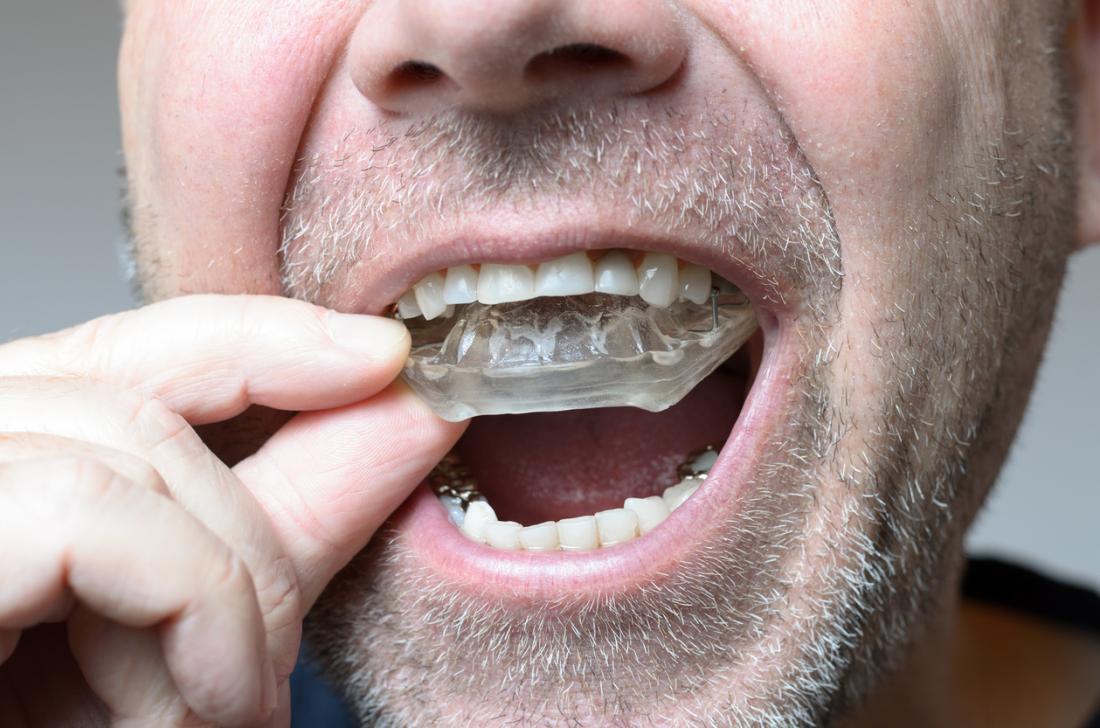Chronic temporomandibular joint (TMJ) pain warrants a trip to the doctor or dentist to assess the cause. Teeth grinding often plays a role, as does a habit of tensing the joint without realizing.
No matter the cause of the pain, exercise can help relieve tension and offer relief.
Exercises for pain relief

The temporomandibular joint is a common source of pain, which may be relieved by some simple exercises.
A few simple exercises can help relieve TMJ pain. People should begin by gently massaging the painful area. This can help reduce tension and pain. It also makes it easier to exercise the joint and the muscles that surround it.
Strengthening exercises
Strengthening exercises are best to perform between TMJ flare-ups. During times of intense pain, they can make the pain worse.
Here are two strengthening exercises:
- Place a thumb under your chin and push your chin downward against it. Continue opening the mouth against moderate force from your thumb, and then hold it open for 5-10 seconds.
- Open your mouth as wide as you comfortably can. Put your index finger between your chin and lower lip. Push inward while closing your mouth against the resistance.
Relaxation exercises
TMJ pain is often the product of tension-producing stress. Simple relaxation exercises can help.
Here are two relaxation exercises:
- Slowly inhale, allowing your stomach rather than your chest to expand. Exhale slowly while making your exhalation last about as long as your inhalation. Repeat 5-10 times.
- While sitting or lying in a comfortably supported position, tense and release tension from each muscle in your body. Begin with the feet and work upwards to the head.
This second exercise is a progressive relaxation exercise to help people become more aware of areas of tension. It may also equip them with the skills to consciously release that tension.
Stretching exercises
Stretching exercises can help with TMJ pain during a flare-up. They reduce muscle and joint tension, offering longer-term relief:
- Place the tip of your tongue on the roof of your mouth. Open your mouth as wide as you comfortably can, and hold for 5-10 seconds.
- Place the tip of your tongue on the roof of your mouth. Glide your lower jaw out as far as it will go and then back in as far as it will go. Hold for 5-10 seconds in each position.
- Slowly and steadily open your mouth as wide as it will comfortably open, with your tongue in a neutral position. Hold for 5-10 seconds then close your mouth. Next, open your mouth slightly and glide your lower jaw back and forth 5-10 times.
- Close your mouth. With your head facing straight ahead, glance to the right with your eyes only. Extend your lower jaw to the left and hold for 5-10 seconds. Repeat on the opposite side.
- Place a thin object, such as a pencil or paintbrush, in between your front teeth. Slide your lower jaw forward so that the object rests in between your back teeth and front teeth. Hold for 20 seconds.
As the fifth exercise becomes easier, people can use wider objects to separate their front and back teeth.
Other ways to manage TMJ pain

A nighttime bite guard may be recommended to manage TMJ pain if it is caused by teeth grinding.
If TMJ pain is caused by teeth grinding or clenching, a nighttime bite guard can help. Although these are available over the counter, a fitted one designed by a dentist offers greater protection and more durability.
Other strategies that can reduce TMJ pain include:
- Applying an ice pack to the affected area for 20 minutes. Some people find that alternating heat and ice, 15 minutes on and 15 minutes off, offers even greater relief.
- Using non-steroidal anti-inflammatory drugs (NSAIDs), such as ibuprofen, to offer temporary relief.
- Massaging the neck and head muscles to control tension radiating from the TMJ.
- Controlling stress and anxiety. Psychological distress can cause people to tense their muscles without thinking, making the pain worse. It may also cause teeth grinding.
Meditation and therapy can help with controlling stress and anxiety. If lifestyle strategies do not work, anti-anxiety medications may be appropriate.
In people whose TMJ pain is not well-controlled by home remedies, a stabilization splint can reduce pain and stabilize the joint.
In some cases, surgery to correct jaw imbalances is another option. These procedures cannot be reversed and can be painful, so people with TMJ pain should try other remedies first.
For people whose TMJ pain is due to missing or broken jaws, jaw implants may offer relief.
Botox is not currently approved for use in the treatment of TMJ pain. Research is currently underway with the aim of shedding light on whether or not Botox is a viable treatment option.
Boxtox is a clinical version of botulinum toxin type A, which paralyzes muscles. It has shown promise in treating other conditions, and some doctors believe it may work in treating TMJ pain.
Causes of TMJ pain
The temporomandibular joint is a hinge action and sliding motion joint. A disc cushions the joint, enabling the jaw to rotate, glide, close, and open. Problems with the muscles surrounding the joints, with the disc that cushions it, or with the joint itself can cause pain.
TMJ pain is often temporary. In other cases, it comes in the form of flare-ups that disappear and then return. TMJ pain can also be chronic and progressive.
The most common causes of pain include:
- a dislocated joint
- issues with tooth and jaw alignment
- arthritis
- muscle tension
- teeth grinding or clenching
People with TMJ pain often hear a clicking sound as the joint moves. Diagnosing the source of any clicks properly, as well as the cause of the pain, is key to creating a treatment plan.
Prevention
Proper dental care can help prevent TMJ pain by maintaining tooth alignment. Cavities, broken or missing teeth, and gum inflammation may make the pain worse.

Maintaining good dental care throughout life may help to prevent TMJ pain.
People should brush and floss their teeth, and aim to see a dentist every 6 months unless recommended otherwise. People should always tell their dentist if they have TMJ pain.
Some other methods for preventing TMJ pain include:
- avoiding chewing gum, taffy, and other very chewy or hard foods
- eating soft food, particularly if prone to TMJ pain
- not chewing on the mouth or tongue
It is also important to chew using both sides of the mouth. Some people with TMJ pain avoid chewing on one side because of pain. Over time, this makes the pain worse.
Let’s block ads! (Why?)





